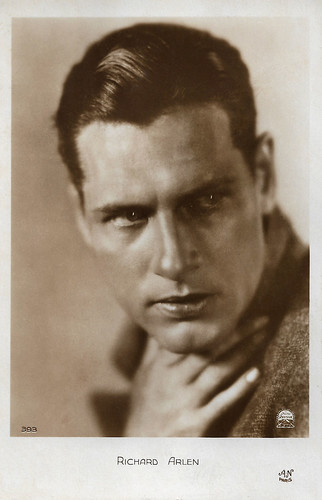
French postcard A.N., Paris, no. 393. Photo: Paramount Pictures Inc.

French postcard by Edition Ross, no. 4340/1, 1929-1930. Photo: Paramount. Clara Bow and Richard Arlen in Ladies of the Mob (William A. Wellman, 1928).
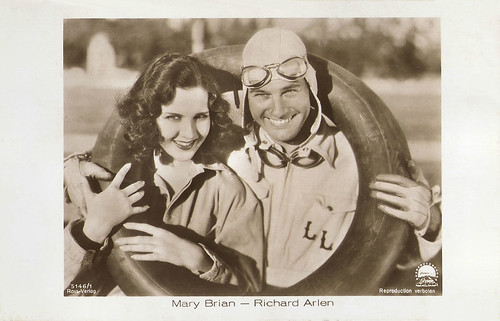
German postcard by Ross Verlag, no. 5146/1, 1930-1931. Photo: Paramount. Mary Brian and Richard Arlen in Burning Up (A. Edward Sutherland, 1930).

German postcard. by Ross Verlag, no. 5403/1, 1930-1931. Photo: Paramount. Mary Brian and Richard Arlenin The Light of the Western Stars (Otto Dyar, 1930).
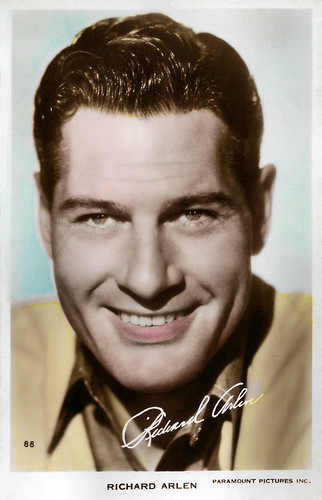
British postcard by Art Photo, no. 88. Photo: Paramount Pictures Inc.
Crashing into the gates of Paramount
Richard Arlen was born Sylvanus Richard Van Mattimore in 1899 (some sources say 1898 or 1900) in St. Paul, Minnesota. Arlen attended the University of Pennsylvania. During World War I, Arlen served in Canada as a pilot in the Royal Canadian Flying Corps. He was assigned the perilous task of taking new planes up to the front lines but he never saw combat.
After the war, he drifted around and eventually wound up in Los Angeles, where he got a job as a motorcycle messenger at a film laboratory. When he was hit by a movie company truck, he crashed into the gates of Paramount Pictures. Arlen suffered a broken leg and the studio provided prompt medical attention. While recuperating in the hospital, studio officials who visited him offered him a chance in pictures, impressed by his good looks.
Starting as an extra in 1921, Arlen soon rose to credited roles, but the quality of his work left much to be desired. His first important film role was in Vengeance of the Deep (Barry Barringer, 1923) starring Ralph Lewis and in which Arlen was billed as Van Mattimore. His big break came when William A. Wellman cast him as a pilot in the silent film Wings (William A. Wellman, 1927) with Charles 'Buddy' Rogers and Clara Bow.
The story of fighter aces would win the Oscar for Best Picture and Arlen would continue to play the tough, cynical hero throughout his career. Arlen appeared in three more pictures directed by Wellman, Beggars of Life (William A. Wellman, 1928), Ladies of the Mob (William A. Wellman, 1928) and The Man I Love (William A. Wellman, 1929).
In Wings (William A. Wellman, 1927), he had a scene with a young actor named Gary Cooper. In 1929, he again worked with Cooper in the Western The Virginian (Victor Fleming, 1929), only this time Cooper was the star and Arlen was the supporting actor.
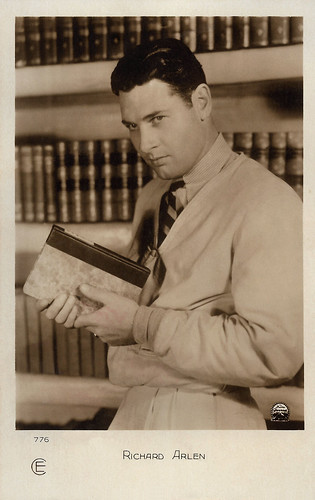
French postcard by Cinémagazine-Edition, Paris (CE), no. 776. Photo: Paramount.
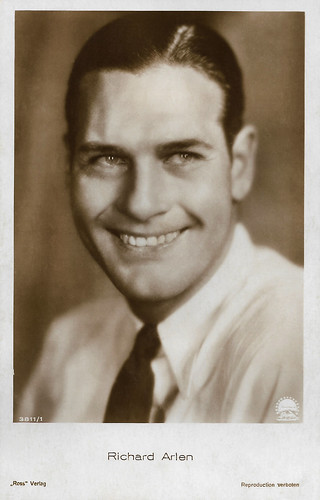
German postcard by Ross Verlag, no. 3911/1, 1928-1929. Photo: Paramount.

German postcard by Ross Verlag, no. 4002/1, 1929-30. Photo: Paramount.

German postcard by Ross Verlag, no. 5553/1, 1930-1931. Photo: Paramount. Mary Brian and Richard Arlen in the car-racing drama Burning Up (A. Edward Sutherland, 1930).
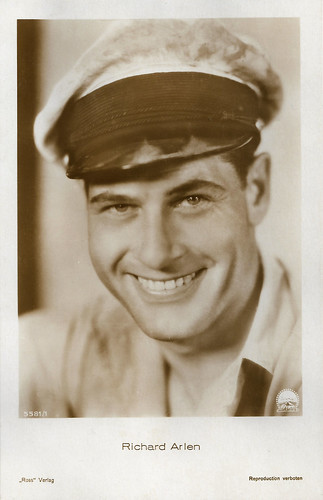
German postcard by Ross Verlag, no. 5581/1, 1930-1931. Photo: Paramount. Richard Arlen in his outfit of The Sea-God (George Abbott, 1930).
His career just bumped along
While Richard Arlen moved easily into sound film, his career just bumped along. It was in 1935 that he became a freelance actor and his freelance career soon waned. He was working in such "B" pictures as Three Live Ghosts (H. Bruce Humberstone, 1936), the Western The Mine with the Iron Door (David Howard, 1936) and the mystery Murder in Greenwich Village (Albert S. Rogell, 1937) with Fay Wray.
In 1939, he signed up with Universal. The studio teamed him with Andy Devine for a series of 14 B-pictures, mostly action comedies with heavy reliance on stock footage from larger-scale films. They are informally known as the "Aces of Action" series, which is how the stars were billed in the trailers. When Arlen left the studio in 1941, the series continued with Devine teamed with a variety of other actors.
In 1941 he moved to the Pine-Thomas unit at Paramount, where he appeared in adventure films and war films. William H. Pine and William C. Thomas were known as "The Dollar Bills" because none of their films ever lost money. Part of the reason Arlen may have made so many for the pair was that he was also a major stockholder in their production company, Pine-Thomas Productions. By the end of the 1940s, Arlen was becoming deaf and this seemed to signal the end of his career. However, he had an operation in 1949 that restored his hearing. In the 1950s and early 1960s, Arlen guest starred in several anthology TV series, including Playhouse 90, The Loretta Young Show, The 20th Century Fox Hour, and in three episodes of the series about clergymen, Crossroads.
He made 15 Westerns for producer A.C. Lyles, who worked with the old Western stars. Besides films and television, Arlen also appeared in commercials. After leaving the business in the late 1960s, he was coaxed back to the screen for three small roles in films, including the comedy Won Ton Ton, the Dog Who Saved Hollywood (Michael Winner, 1976) starring Bruce Dern. Spoofing the craze surrounding the film dog Rin Tin Tin, the film is notable for a large number of cameo appearances by Paramount stars from Hollywood's golden age. Paramount Pictures was the film's distributor.
Richard Arlen was married three times. His first wife was Ruth Austin, from 1920 to 1923. He married his second wife, actress Jobyna Ralston, in 1927. They were among the more famous residents of the celebrity enclave of Toluca Lake, California. The couple had a son, Richard Arlen Jr., who also did some acting. In 1945, the couple divorced and Arlen married New York socialite, Margaret Kinsella in 1946. Arlen died of emphysema in 1976 in North Hollywood at the age of 76 (some sources say 75 or 77). He was interred at Holy Cross Cemetery in Culver City, California.
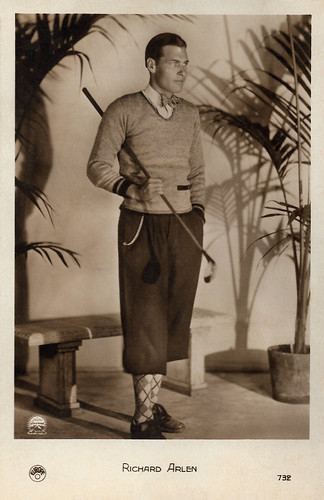
French postcard by Europe, no. 732. Photo: Paramount.
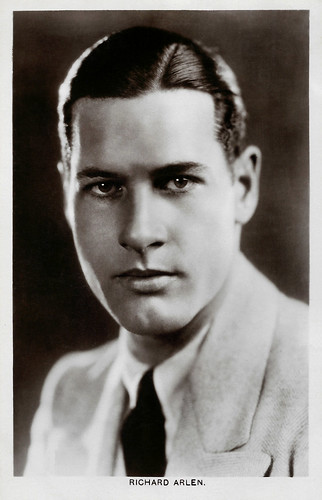
British postcard in the Picturegoer Series, London, no. 350.
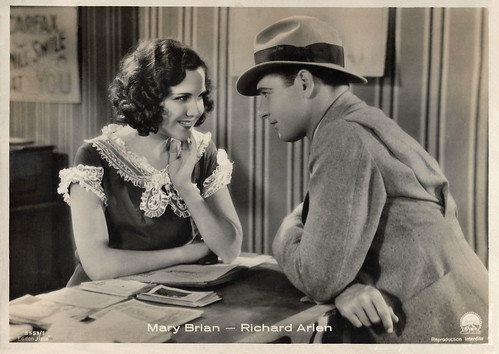
French postcard by Edition Ross, no. 3553/1. Photo: Paramount. Mary Brian and Richard Arlen in the car-racing drama Burning Up (A. Edward Sutherland, 1930).

German postcard by Ross Verlag, no. 6206/1, 1931-1932. Photo: Paramount. Frances Dee and Richard Arlen in Caught (Edward Sloman, 1931).
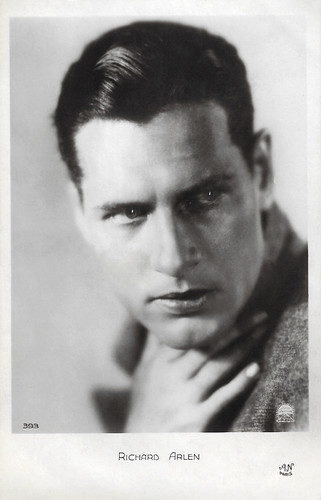
French postcard by A.N., Paris, no. 393. Photo: Paramount.
Sources: Tony Fontana (IMDb), Golden Silents, Wikipedia (English, French and German) and IMDb.
No comments:
Post a Comment